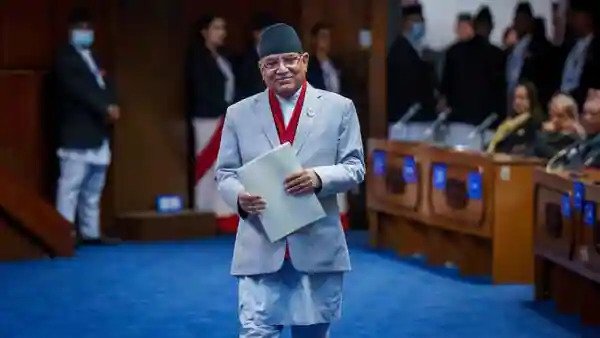KATHMANDU, Dec 26 (PTI): Pushpa Kamal Dahal “Prachanda” was on Monday sworn-in as the Prime Minister of Nepal for a third time, a day after the former guerrilla leader dramatically walked out of the pre-poll alliance led by the Nepali Congress and joined hands with opposition leader K P Sharma Oli.
The 68-year-old CPN-Maoist Centre chairman was appointed as the country’s new Prime Minister on Sunday after he submitted a letter to President Bidya Devi Bhandari showing the support of 169 members in the 275-member House of Representatives.
Prachanda took the oath of office and secrecy from President Bhandari at an official ceremony at Shital Niwas on Monday.
President Bhandari also administered the oath to other cabinet members of the new coalition government. The new cabinet has three deputy prime ministers – Bishnu Paudel from Oli’s CPN-UML, Narayan Kaji Shrestha from CPN-Maoist Centre and Rabi Lamichhane from Rashtriya Swatantra Party (RSP).
Paudel was assigned to the Finance ministry while Shrestha got Physical Infrastructure and Transport and Lamichhane home ministry.
Jwala Kumari Sah, Damodar Bhandari and Rajendra Kumar Rai – all three from Oli’s CPN-UML – have been made ministers. Janamat Party’s Abdul Khan was also appointed as a minister.
Despite getting appointed Prime Minister with an overwhelming majority, Prachanda will now have to win a vote of trust from the lower house within 30 days.
If he fails to win the confidence of the House, then a new process for government formation will begin.
The surprise development of Prachanda becoming the new premier may not bode well for India-Nepal ties as he and his main backer and former premier Oli have had some run-ins with New Delhi previously over territorial issues.
Oli on Sunday outfoxed his bete noire and ex-prime minister Sher Bahadur Deuba, a veteran of manoeuvring hung parliaments to his advantage.
Deuba congratulated Prachanda over the phone during the Maoist office meeting held on Monday morning. He was also present at the oath ceremony.
Prachanda, who is seen as pro-China, has in the past said a new understanding with India needed to be developed on the basis of a “changed scenario” in Nepal and after addressing all outstanding issues, like revision of the 1950 Friendship Treaty and resolving Kalapani and Susta border disputes.
The India-Nepal Treaty of Peace and Friendship of 1950 forms the bedrock of the special relations between the two countries.
In recent years, Prachanda, however, has said India and Nepal need to address diplomatically some of the issues “left by history” to realise the full potential of the bilateral cooperation.
His main backer Oli is also known for his pro-China stance. As the Prime Minister, Oli last year claimed that efforts were being made to oust him after his government redrew Nepal’s political map by incorporating three strategically key Indian territories, a move that strained ties between the two countries.
India had termed as “untenable” the “artificial enlargement” of the territorial claims by Nepal after its Parliament unanimously in 2020 approved the new political map of the country featuring Lipulekh, Kalapani and Limpiyadhura areas which India maintains belong to it.
The country shares a border of over 1,850-km with five Indian states – Sikkim, West Bengal, Bihar, Uttar Pradesh and Uttarakhand.
Land-locked Nepal relies heavily on India for the transportation of goods and services. Nepal’s access to the sea is through India, and it imports a predominant proportion of its requirements from and through India.
Born in Dhikurpokhari of Kaski district near Pokhara on December 11, 1954, Prachanda remained underground for almost 13 years. He joined mainstream politics when the CPN-Maoist adopted peaceful politics, ending a decade-long armed insurgency.
He led the decade-long armed struggle from 1996 to 2006 that ultimately ended with the signing of the Comprehensive Peace Agreement in November 2006.
There has been an understanding between Prachanda and Oli to lead the government on a rotation basis and Oli agreed to make Prachanda Prime Minister at the first chance as per his demand.
On Sunday, Prachanda walked out of the Nepali Congress-led five-party alliance after Nepali Congress president Deuba rejected his bid to become the Prime Minister in the first round.
Deuba and Prachanda had earlier reached a tacit understanding to lead the new government on a rotational basis.
During talks with Prachanda on Sunday morning at the PM House, Nepali Congress had staked a claim for both the key posts of President and Prime Minister, which Prachanda had rejected, resulting in the failure of the talks, Maoist sources said.
After talks with Prime Minister Deuba failed, Prachanda reached the private residence of CPN-UML chairman Oli to seek his support to become the Prime Minister. Leaders of other smaller parties joined him.
Not only did Oli succeed in getting Prachanda anointed as the prime minister, a move which weaned Prachanda away from the Congress-led alliance, but he also now gets to have his own candidate for the head of the state and the Speaker of the House of Representatives along with plum ministries and a majority of the provincial chief ministers.
The new alliance of the seven parties seems to be headed to form governments in all seven provinces.
The wheel turned full circle since Prachanda and Oli were allies till the former broke away last year and backed Deuba for the prime minister.
Until Sunday afternoon, a Nepali Congress-led coalition led by Deuba was the favourite to form the next federal government. The Oli masterstroke means that he will now get to pull the strings of power.
The Deuba-led Nepali Congress is the largest party with 89 seats in the House of Representatives while CPN-UML and CPN-MC have 78 and 32 seats, respectively. No party has 138 seats required to form a government.
In the House, CPN (Unified Socialist) has 10 seats, Loktantrik Samajwadi Party (LSP) has four, and Rastriya Janamorcha and Nepal Workers and Peasants Party have one seat each.
There are five independent members in the Lower House.







